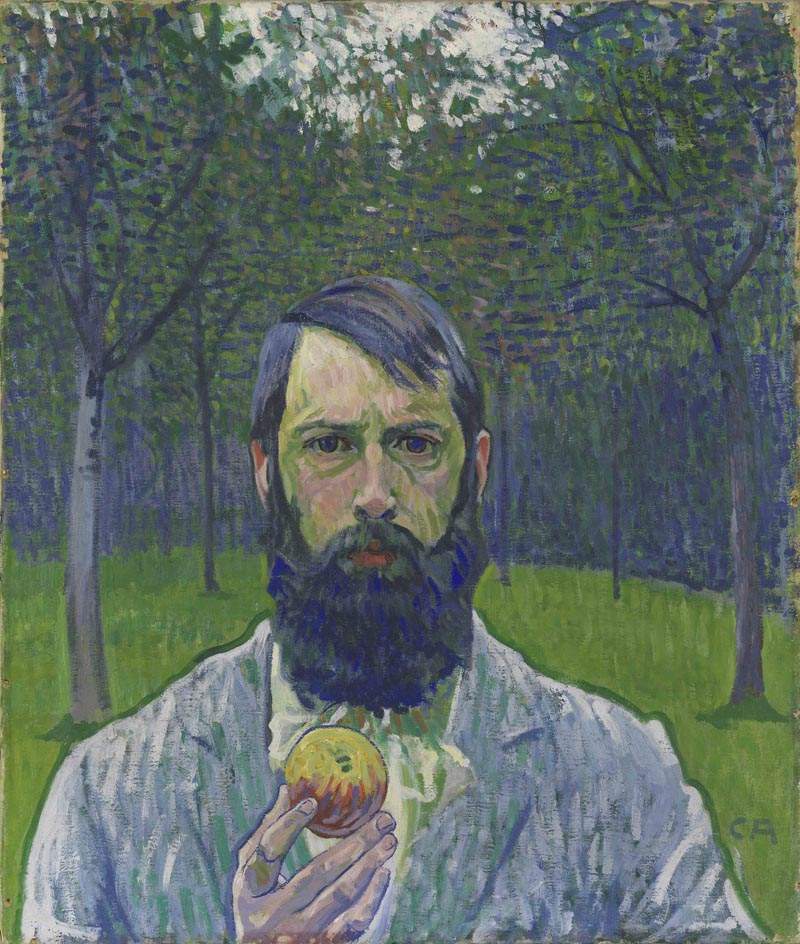Cuno Amiet: Swiss postimpressionist between Gauguin, Kirchner and Matisse on exhibition
The exhibition on Cuno Amiet (Solothurn, 1868 - Oschwand, 1961) at the Mendrisio Museum of Art in Mendrisio (Switzerland, Canton Ticino) continues until January 28, 2018 (it started last October 22). The exhibition, titled Cuno Amiet’s Paradise. From Gaugin to Hodler, Kirchner to Matisse, turns the spotlight on the very long career of Cuno Amiet, one of the great protagonists ofSwiss art between the 19th and 20th centuries, the main exponent of postimpressionist painting in French-speaking Switzerland, counterbalance to what, for the German-speaking area, was Ferdinand Hodler (between 2011 and 2012, at the Kunstmuseum in Solothurn, there was precisely an exhibition comparing the works of the two great Swiss artists).
Amiet lived through many seasons: as a young man, he left for Paris and Brittany to follow in the footsteps of the Nabis and Paul Gauguin (he stayed for some time precisely in Pont-Aven, a place consecrated to the art of the great French painter) and to hone his skills as a colorist. Looking to the works of his fellow countryman Hodler, who was fifteen years his senior, Amiet renewed local painting to a considerable degree, but his curiosity later led him to engage with the new German expressionist painting: Indeed, he joined the Die Brücke group, which included painters of the caliber of Ernst Ludwig Kirchner and Erich Heckel, and marked a turning point in his own art under the sign of bolder compositional choices and brighter, more squillant colors, thanks in part to his nature as a versatile and experimental painter. The result is an art that combines the spirituality of the Nabis, the joie de vivre typical of the Fauves led by Henri Matisse, and the tense painting of the German Expressionists.
Prevalent in his paintings are landscapes, figures and still lifes that instill a great sense of harmony, and it is from this characteristic of his art that the title of the exhibition, curated by Simone Soldini, director of the Mendrisio Museum of Art, Franz Müller, author of the comprehensive catalog raisonné of Amiet’s work, and Aurora Scotti, a specialist in late 19th- and early 20th-century art, originates. “For most of his life,” we read in the exhibition presentation, "Amiet painted in the Bernese countryside, in Oschwand, in an environment of unspoiled rural beauty. Figures, landscapes, the interiors and still lifes themselves, always bring to mind-through colors, lights and compositional cuts-an impression of Arcadia, of an earthly paradise, which is punctuated by human relationships, by work in the fields, by love for one’s neighbor and family, by man’s immersion in nature. It is a basic underlying sentiment in Amiet’s work, consistent and found throughout. Moreover, one of the masterpieces of his extreme maturity, when he had already lost his lifelong companion, is titled Paradise on Earth (Paradies) and depicts an angelic scene in a bucolic atmosphere connoted by a very intense golden luminosity."
The Mendrisio exhibition showcases several of Amiet’s works from public and private collections, from the earliest works created during his stay in Pont-Aven (Breton Girl from the Kunstmuseum in Solothurn and Breton Boy from the Kunsthaus in Zurich), to Paradise from a private collection, a subject he would return to at the end of his career with the 1958 Paradise from the Kunstmuseum in Bern, to works from his Parisian stay and those of his later years. Then there are some comparison works by the artists with whom the Swiss artist’s inspiration was measured: Paul Gauguin (a Landscape of Brittany from a private collection), Émile Bernard(Breton Scene), Henri Matisse (a Nude from the Museo d’Arte della Svizzera Italiana in Lugano), Ferdinand Hodler(Portrait of Jeanne Charles Cerani), Ernst Ludwig Kirchner(House with Flowering Trees from the Kirchner Museum in Davos), Alexej von Jawslensky(Young Boy from the Locarno Municipal Collection), August Macke(Bathers with Trees of Life), Gabriel Münther(Farm near Murnau), Giovanni Giacometti(Portrait of Cuno Amiet and Piazzetta), Marianne Werefkin (a sketchbook), Ernst Morgenthaler(Landscape near Hellsau). Also on display is a work by Pietro Chiesa, one of the artists most influenced by Amiet.
The exhibition is organized together with the Amiet Foundation in Oschwand. It is open Tuesday through Friday from 10 a.m. to noon and 2 p.m. to 5 p.m., and on Saturdays, Sundays and holidays continuously from 10 a.m. to 6 p.m. Mondays are closed (except holidays). Also closed on December 24 and 25, and January 1. Tickets: full price is 10 euros, reduced price 8. Also scheduled are free educational activities for preschool, elementary and middle school children. For high schools, visits at a cost of 60 euros per schoolchild. Guided tours for groups with art historians (maximum 25 people) at a cost of 90 euros per group. A package with admission to the exhibition, guided tour and lunch in a Ticino grotto can be booked on request. Side activities are also planned, including a concert for Amiet, conference on exhibition-related topics, and afternoons dedicated to families and children. Media partner RSI Rete Due. Catalogue-monograph of 160 pages with color illustrations of all works in the exhibition and essays by Simone Soldini, Franz Müller, Aurora Scotti and Viola Radlach (on sale for 35 euros). For all information you can visit the Mendrisio Art Museum website.
Image: Cuno Amiet, Self-Portrait with Apple (1902-1903; oil on canvas, 64.5 x 54 cm; Private collection, in storage at Kunstmuseum Solothurn) © M. + D. Thalmann, Herzogenbuchsee. Photo credits: SIK-ISEA, Zurich (Philipp Hitz).
 |
| Cuno Amiet: Swiss postimpressionist between Gauguin, Kirchner and Matisse on exhibition |
Warning: the translation into English of the original Italian article was created using automatic tools. We undertake to review all articles, but we do not guarantee the total absence of inaccuracies in the translation due to the program. You can find the original by clicking on the ITA button. If you find any mistake,please contact us.





























